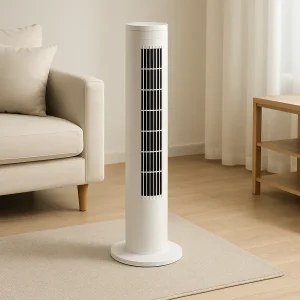Choosing the right fan for your space can feel overwhelming. With so many types—each claiming to offer efficiency—it’s easy to make a costly mistake. But when airflow, energy savings, and cost efficiency matter most, understanding fan types is your best solution.
The most efficient fan type depends on your space and purpose. For large areas, HVLS and centrifugal fans are the most energy-efficient. For homes or offices, ceiling fans, tower fans, and smart pedestal fans offer effective cooling with low energy use.

Industrial HVLS fans installed in warehouse ceiling
Fan efficiency isn’t just about speed or how strong the breeze feels—it’s about how much ar que um ventilador pode mover with the least amount of consumo de energia. Efficiency varies based on:
Fans that mover ar effectively while drawing minimal power reduce operating costs, improve comfort, and lower environmental impact. High-efficiency fans also produce less noise and last longer with proper care.
Key efficiency measures:
| Recurso | Efficient Fans Offer |
|---|---|
| Airflow Volume | High CFM rating for space coverage |
| Energy Use | Low wattage or energy star rated |
| Durabilidade | Industrial-grade motor, bearings, and housing |
| Smart Control | Variable speed, motion sensor, or remote |
To make a smart decision, it’s essential to compare different tipos de fãs and their efficiency across real-world applications.
Ventiladores centrífugos are commonly used in industrial settings where high pressure airflow is necessary. These fans pull air into the fan wheel and push it out at a 90-degree angle, creating high static pressure—ideal for ductwork, sistemas de ventilação, e alta temperatura ambientes.
Why centrifugal fans work best:
However, centrifugal fans are usually larger, noisier, and more expensive than ventiladores de torre ou ventiladores de pedestal. They are efficient in specific environments, not for household cooling.
Explore how centrifugal fans work in large commercial setups
Ventiladores axiais, on the other hand, are widely used across applications—from cooling fan units in electronics to large-scale arrefecimento industrial. They operate by moving air parallel to the fan blade axis and are best for situations needing high airflow at low pressure.
Axial fans tend to consume less energy when not battling pressure loads, making them more energy efficient in open spaces.
Tower fans are a popular choice in homes and offices due to their compact size, modern design, and oscillating airflow. Although they don’t produce high CFM like industrial fans, they circular ar well in small to medium rooms.
However, the velocidade do ventilador and airflow power are limited compared to ventiladores axiais ou ventiladores centrífugos. If you’re choosing a fan to cover large areas like armazéns ou academias, tower fans are not the best option.

Slim tower fan for home use
Fãs de pedestal e ventiladores de mesa are flexible and portable, making them perfect for temporary or personal cooling. These electric fans can be easily moved between rooms, adjusted for velocidade do ventilador, and tilted to direct airflow.
While they offer decent energy savings and airflow direction control, pedestal and table fans are not designed to mover grandes quantidades de ar. They are not suitable for environments requiring strong, continuous ventilação or cooling.
Sim-ventiladores de teto remain one of the best ways to circular ar efficiently, especially in industrial ou comercial spaces with high ceilings. Their energy draw is minimal compared to ar condicionado units, and they help keep ar quente down in the winter and ar frio moving in summer.
Modern ceiling fans, especially Fãs HVLS (high-volume, low-speed), offer massive economia de energia. Esses fãs trabalham eficientemente em fábricas, academias, e centros esportivos, delivering comfort with low operating costs.
Discover how ceiling fans help cool large facilities
Bladeless fans are quieter and safer, with a futuristic design that draws air into the base and pushes it through a ring to ar frio effectively. They’re best for homes or offices prioritizing safety and aesthetics.
Smart fans, whether tower or pedestal, integrate with apps and voice assistants, allowing users to set timers, schedules, and speed automatically. They offer convenience and eficiência energética when cooling is needed in short bursts.
However, these fans are often costly and are more suited to personal use rather than ventiladores industriais needs. For large facilities, centrífuga ou Fãs HVLS remain the best options.
Quando se trata de arrefecimento industrial, only certain tipos de ventiladores meet the demand for volumes de ar, low noise, e long-term durability.
Cada tipo de ventilador has specific applications. For example, ventiladores centrífugos pega alta temperatura, serviço contínuo operations. Fãs HVLS são ideais para cooling your home or business efficiently without high energy bills.

ventilador hvls em um grande armazém
When selecting a fan to move air across wide or tall areas, it’s important to consider design de ventilador, lâmina do ventilador size, and application. Here’s how some different types of fans compare:
| Tipo de ventilador | Melhor para | Eficiência | Cobertura |
|---|---|---|---|
| Tower fan | Bedrooms, offices | Moderado | Small |
| Ventilador de pedestal | Personal cooling | Good | Médio |
| Ceiling fan / HVLS fan | Warehouses, gyms | Excelente | Very large |
| Ventilador centrífugo | Industrial exhaust | Alto | Alta pressão |
| Ventilador axial | General ventilação | Alto | Wide area |
| Smart fan | Homes, offices | Good | Small to medium |
| Bladeless fan | Safety and style | Moderado | Small |
Axial fans move air in a straight path, making them great for continuous ar condicionado or supply needs. Ventiladores centrífugos pull air into the center and push it out at a 90-degree angle, useful in high-pressure, ducted sistemas.
Ventiladores HVLS (alto volume, baixa velocidade) representam o auge de ventilador industrial engineering. These large ventiladores de teto span up to 24 feet and mover ar gently but thoroughly across vast spaces.
These fans are not just about airflow—they impact your facility’s overall consumo de energia, conforto, e operating costs. Compared to traditional ar condicionado units, HVLS fans provide better ROI, especially when paired with smart controls.
Explore more: HVLS fans for commercial applications
Um energy-efficient fan balances fluxo de ar with minimal power usage. This depends on:
To achieve economia de energia, many businesses switch from electric fans e air conditioners to HVLS or ventiladores centrífugos for long-term savings.
Escolhendo o fã direito depends on your specific space and needs. Ask:
If you manage a facility such as a armazém, academia, ou fábrica, the right answer is almost always an ventilador industrial like HVLS or centrífuga types.
How to select the best HVLS fan for your factory
Which type of fan is most energy-efficient?
The most energy-efficient fan is the HVLS (High Volume Low Speed) fan for large commercial or industrial spaces. For residential settings, ventiladores de teto com estrela de energia certification and brushless DC motors offer excellent efficiency.
What is the difference between axial and centrifugal fans?
Ventiladores axiais move air in a straight line and are best for moving large volumes at low pressure. Ventiladores centrífugos, on the other hand, are designed to generate higher pressure and are ideal for ducted ou exaustor sistemas.
Do fans really help with air conditioning efficiency?
Yes. Fans, especially ventiladores de teto, help circular ar and reduce hot or cold spots. This lets you raise the termostato in summer or lower it in winter, reducing consumo de energia without sacrificing comfort.
Are bladeless fans worth it?
Bladeless fans offer safety, quiet operation, and modern design. However, they typically mover menos ar than traditional lâmina do ventilador models and may not be ideal for arrefecimento industrial.
Which fan works best for gyms or sports centers?
Grande Fãs HVLS are the best option. They cover wide areas, circular ar efficiently, and provide arrefecimento without noisy operation, making them ideal for athletic facilities.
How often should I maintain industrial fans?
It’s recommended to follow a strict calendário de manutenção: check for vibração, lubricate bearings, inspect motor health, and clean the pás do ventilador every 3–6 months for optimal performance.
To wrap up, here’s what you need to remember when choosing the most ventilador eficiente for your space:
Whether you’re managing a fábrica, outfitting a commercial gym, ou installing ventilation in a armazém, selecting the right tipo de ventilador ensures better comfort and eficiência energética.

Olá, eu sou Michael Danielsson, CEO da Vindus Fans, com mais de 15 anos de experiência na indústria de engenharia e design. Estou aqui para compartilhar o que aprendi. Se você tiver alguma dúvida, sinta-se à vontade para entrar em contato comigo a qualquer momento. Vamos crescer juntos!